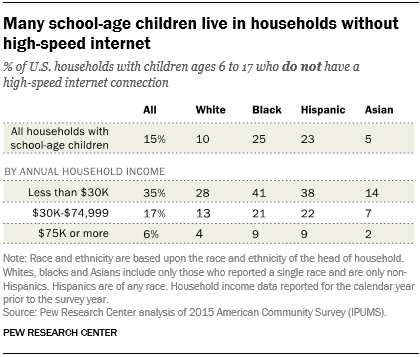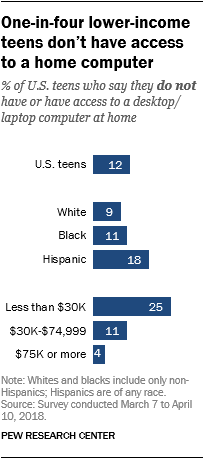
Share On Social!
Nearly 1 in 5 U.S. households with school children do not have high-speed Internet access at home, and 1 in 4 low-income teens have no access to a computer at home, according to a new analysis by Pew Research Center.
This causes a “homework gap.”
Latinos and other youth of color, especially those from low-income families, are more likely to face this digital divide at home to complete tech-based school homework.

Latino and other minority students are already at a significant disadvantage due to an unhealthy school environment and less physical activity, according to a Salud America! Research Review. Additionally, Latino and other minorities, both children and adults, suffer a big lack of access to support for economic and education success, which makes it extremely difficult for Latinos and other minorities to achieve academically, socially, and physically.
“Numerous policymakers and advocates have expressed concern that students with less access to certain technologies may fall behind their more digitally connected peers,” according to the Pew research. “There is some evidence that teens who have access to a home computer are more likely to graduate from high school when compared with those who don’t.”
Digital Inequities
About 1 of 3 households with children ages 6-17 and whose annual income is below $30,000 a year do not have a high-speed Internet connection at home. Less than 1 in 10 households earning $75,000 or more do not have access, according to the Pew analysis.
Roughly 31% of households who had an income lower than $50,000 a year with school aged kids lacked broadband access. Furthermore, 40% of households who had annual incomes of less than $25,000 lacked broadband access at home—this percentage was even greater among Latino and Black households.
In contrast, children in families who had an income of $150,000 lacked broadband access at a very low percentage (3.3%), which included 3% of children in White households and 2.1% of children in Asian households.
However, even at greater income levels, Latinos and Blacks are still lagging behind.
Latino and Black children in households with incomes higher than $150,000 annually fell 4% behind White and Asian households.

Other Homework Challenges
Black and Latino youth also face other technological disadvantages when working on tech-based homework:
- 80% of Latino students who do not have regular access to a computer at home use their smartphones to access the internet and do their homework that requires broadband access.
- Latinos also were found to be the most likely to not complete assignment because of lack of access and most likely to believe they received a lower grade because of their lack of access to the internet.
- 19% of students from “underserved” backgrounds report having access to only one device at home.
- 56% of students who say they have access to only one device at home indicated that it was a smartphone.
- 24% of students who live in rural areas report having access to only one device, compared to 14 percent of those who live in urban areas.
Ultimately, Latino and Black children disproportionately suffer a digital divide.
This results in these children having greater difficulty doing their homework, which in turn means less opportunity to succeed academically and socially in the future.
Solutions to Combat Digital Equity
It is critical to look at the broader implications of broadband access, and the history as to why the inequity exists.
Schools can also help.
In Coachella Valley, Calif., the school district used school buses as a large mobile hotspot and parked the vehicles in trailer parks, to bring Internet access to kids who would not have it otherwise, according to Education Week.
“Some research suggests that access to devices is connected to positive outcomes for students. It appears to boost students’ self-reliance as learners and their development of sustainable mindsets for learning, according to Project Tomorrow’s Speak Up Research Project for Digital Learning,” according to Education Week.
Making school districts aware of the digital inequities aware facing their students is another way to move forward.
“We want educators to embrace technology,” Sarah Thomas, who is on the leadership team at ISTE Digital Equity Professional Learning Network, told Education Week. “But we also have to be mindful that not all students have access to the same things. We have to be mindful not to exacerbate existing inequalities.”
By The Numbers
142
Percent
Expected rise in Latino cancer cases in coming years



